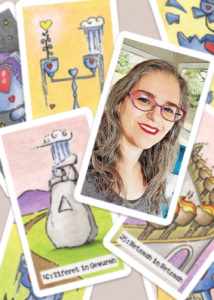
Creating a tarot card deck had long been on graphic designer Mishka Jaeger’s bucket list.
“I always wanted to illustrate a tarot card deck. I love the spirituality. I like the woo-woo factor of it,” said Jaeger, 49, a Reston resident and member of Temple Rodef Shalom. “It’s just one of these sort of things illustrators often want to do because it’s a codified set project. It’s got rules.”
Over the centuries, tarot cards have come to be used as a tool of divination. But when Jaeger finally began hers, she found a way to make it Jewish.
In her research, Jaeger discovered that the cards have been used by Jews to meditate during the Omer period — the 49 days between the second night of Passover and Shavuot.
Her plan is to design a card to meditate on each day. “I’ve never seen anyone do it,” she said.
The Omer period has a much longer history than tarot cards, which may have developed in northern Italy as playing cards in the 14th century. The Omer period originated in the time of the ancient barley harvest and “omer” is a Hebrew unit of measurement for sheaves.
The commandment to count each of the 49 days is found in Leviticus 23:15-16. The period developed into a time of semi-mourning and also took on a mystical aspect.
The 16th-century kabbalists developed a list of intentions, or kavanot, for each week of the counting, each inspired by one of the sefirot or attributes God. Each day was a step toward greater moral refinement, in preparation for the giving of the Torah on Shavuot.
Counting the Omer, or sefirat ha’Omer, ends on May 16.
To design a card, Jaeger first sketches on paper, then transfers the design to cardstock and colors it in with pencil. Jaeger then scans the card onto her computer and touches it up digitally. She said it takes her about 16 hours to finish a single card.
“Illustration is non-trivial. Everyone thinks it happens quickly, but I’m not the fastest Illustrator,” she said.
Jaeger said she based her design on the 1909 Rider-Waite tarot deck, widely considered the most popular tarot deck. Each of her cards features a primary image based on a weekly theme of the Omer. Jaeger used cups of water to represent the first week, Chesed (lovingkindness), “because love flows [just like] water flows.”
For the third week, flowering trees represent Tiferet (harmony, balance), “because we’re in the spring and nature is full of harmony and balance.”
She modifies these primary images to match the specific day’s theme.
“It’s a little esoteric, but my point is that I want people to look at the cards and the pictures and work out for themselves what they’re seeing as part of the meditation.”

Jaeger has been interested in art for as long as she can remember. She grew up in Arkansas, later New York, and studied scenery design and technical theater at Syracuse University. After earning her bachelor’s degree in 1994, she moved to California with the goal of making a living designing movie sets.
But in the end, she found her niche in graphic design for websites. She has worked on the websites of 20th Century Fox and Mattel. Jaeger also did some coloring work for Scholastic and Marvel’s Generation-X comic book series, a spin-off of the X-Men franchise. In 2002, Jaeger moved to the Washington area and has done visual design work for K-12, an education management organization based in Herndon, ever since.
It was the 100 Days Project, an annual call for artists to work on a project every day for 100 hundred days, that spurred her to finally start on her tarot cards.
The project began on Jan. 31 and will end a week after sefirat ha’Omer. Jaeger is posting a card on Instagram (@mishkajaeger) and Facebook (@mishkajaegersketchbook), corresponding to the day of the Omer.
Jaeger hopes people will use them to meditate with and reflect on the themes of each day of the Omer. When Jaeger meditates for Omer, she tries to think about how the concepts the card depicts intersects with her own life.
“This [project] is an opportunity to think about how you can make changes in your life, to grow spiritually between Passover and Shavuot using the concepts in the cards,” Jaeger said. “So I’m doing this for myself, doing my own meditations and thinking about these things for myself, [and] I’m hoping other people can also have these little bites as well.”
[email protected]
@EricSchucht





